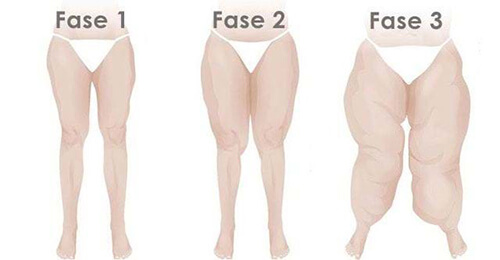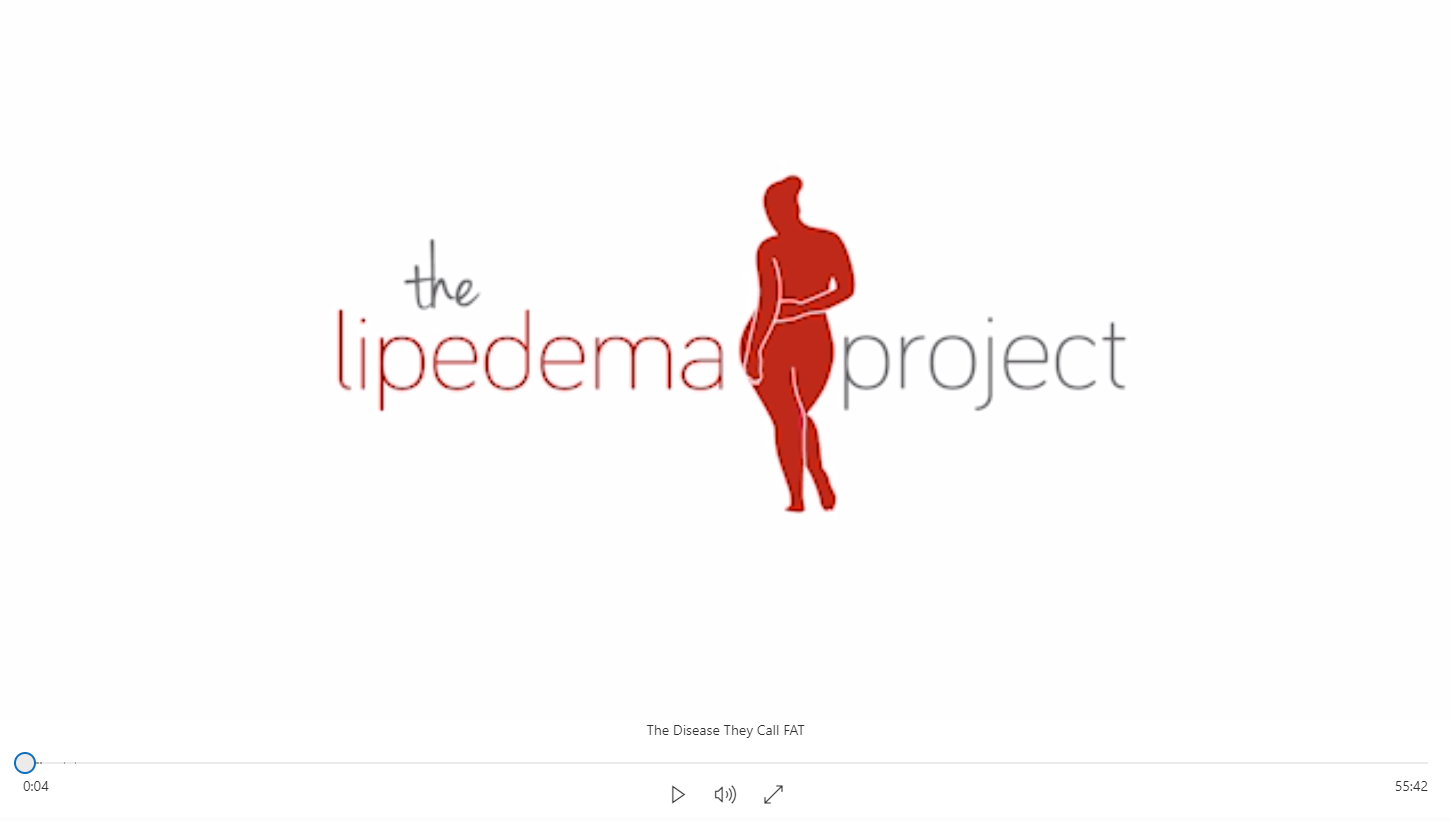There are several of definitions of this condition. In general, lipoedema is defined as a redistribution of fat and fluid under the skin. Lipoedema occurs most commonly in the legs, though also on the arms, thighs and buttocks. The condition can occur regardless of body weight.
Lipoedema is a progressive condition which means that, if not treated properly, the accumulation of fat and fluid increases slowly but steadily. The cause of lipoedema has not yet been fully scientifically proven. It is highly likely that genetic predisposition is involved, along with disruption of the finest capillaries (microangiopathy) of adipose tissue, affected by increased permeability. It is possible, however, for lipoedema to occur even without similar cases in the family. As the disorder occurs almost exclusively in women, a hormonal cause is also very plausible. Difficult words are used in this section, so simplify or explain some concepts.
A precise definition should refer to lipohypertrophy or dystrophy (a disorder of fat distribution). Only when the swelling component – oedema – increases is it referred to as lipoedema. Lipoedema is distinguished from obesity or adimosis dolorosa (also known as Dercum's disease, adipose tissue rheumatism, neurolipomas or lipalgia syndrome), when it involves localised fat deposits that are severely painful. This is a neurological condition detected with a histological examination of fat tissue.

Lipoedema is often confused with obesity
Lipoedema itself is often overlooked by (general) physicians or confused with obesity or lymphoedema. Patients often endure a long ordeal before the correct diagnosis and treatment option is advised. Particularly burdensome for these patients are the symptoms of lipoedema due to the fat and fluid deposits. Swelling in the subcutaneous tissue of the lower leg is caused by a disrupted lymphatic system (increased capillary permeability for fluid and obstruction of lymphatic drainage).
At the onset of the condition, the oedema is barely visible, if at all. Still, often in the evening, these patients experience swollen legs. This is exacerbated by prolonged standing or sitting, especially in the summer season. The symptoms worsen over the years, including, for example, swelling in the lower and upper leg that does not decrease at night. This water retention (gravity) causes feelings of tension and, when touched and/or pressed, pain.
In most cases, lipoedema patients are women. They suffer psychologically from the condition and often face a frequent lack of understanding from those around them. They are often advised, for instance, that dieting and exercise are the solution to their problem, yet this is only a small portion of the solution. Despite all measures such as dieting, fatty tissue on the legs or arms continues to increase. Usually, the torso is leaner creating a disproportionate appearance compared to the legs and/or arms.
Lipoedema is a disease and can only be treated by experienced doctors with extensive knowledge about this condition. Lipoedema comprises several stages, and identifying these stages determines treatment options and treatment advice. Proceeding too quickly to surgery is not always the best option.
Schedule an appointment with Dr. Don?
Three stages of lipoedema
The development of lipoedema comprises three stages and these may also overlap. This is not always easily discernible. Exclusion of other causes of a swollen leg is necessary. It is not only lipoedema that can trigger swelling of the legs. There may also be weak veins, otherwise known as venous insufficiency. Potential causes such as heart and kidney diseases, orthopaedic problems, rheumatological causes or changes in blood composition must be ruled out.

Fase 1 van lipoedeem
The skin is still smooth but the subcutaneous tissue (subcutis) is thicker and the fat appears nodular in structure. This is the most common stage (cellulite). Patients complain of swelling of the legs and/or arms while sitting or standing. The swelling decreases at night or while lying down. This stage can last a lifetime. In some cases, deterioration may occur. The most common cause of deterioration is severe weight gain. Any weight gain leads to disproportionate fat deposits in the legs, which can only be lost with difficulty during weight loss later.
Fase 2 van lipoedeem
In stage two, there are major changes in the adipose tissue. The skin is uneven with lumpy structures.
Fase 3 van lipoedeem
In stage three, the skin begins to deform into lobe-like shapes that are often rough to the touch.
Difference between lipoedema and lymphoedema
In addition to lipoedema, lymphoedema is also a condition. Lymphoedema also involves swelling though it differs significantly from lipoedema. Lymphoedema, however, is often seen in combination with lipoedema. Lymphoedema generally occurs first on the feet and toes. Suddenly, not a single shoe fits. The swelling in lymphoedema also increases during the day and decreases again at night. Unlike lipoedema, lymphoedema can cause hardening of the tissue over time (tissue sclerosis). Unlike lipoedema, lymphoedema is not painful, no matter how large and pronounced the swelling.
The above description mainly refers to ‘acquired lymphoedema’, which generally occurs in women around the age of 30 (lymphoedema tarda). There may also be congenital lymphatic malformation. This swelling typically occurs on one arm or one leg. In exceptional cases, lymphoedema can also occur as a result of trauma to the lymphatic vessels, such as after a lymph node dissection following radiotherapy or surgery, etc.
The lymphatic system comprises a separate network of vessels in the tissue. Lymphatic vessels transport lymph (protein-rich fluid) back to the bloodstream via the lymph nodes. Lymphatic vessels have intermediate stations, called lymph nodes, and are found every few centimetres in the body. The lymphatic system has many other functions, such as disease control and the immune defence system. In this context, we will discuss only the vascular function in addition to the return of fluid to the body.
In severe lipoedema, a large storage of lymphatic tissue exists. After treatment of the lipoedema, lymphatic function improves.
Examination and diagnostics of lipoedema
An experienced physician should be able to identify the presence of lipoedema at a glance. Lipoedema has characteristic features that allow for a swift diagnosis. The legs and/or arms, for example, appear too thick compared to the rest of the body (trunk). Lipoedema of the lower leg starts at the level of the ankle and generally affects the entire leg. The area below the ankle at the back of the foot (heel) and the dorsum of the foot are spared. Increased fatty tissue thickens; this is inward and/or outward. Classic fat deposits such as the ‘saddlebags’ or between the thighs are even more pronounced. In some cases, this also extends to the buttocks but not necessarily.
‘Pinch-test’
The pinch test is used to assess the thickness of the lower body connective tissue. This is done by forming a skin fold and measuring it. In severe cases of lipoedema, no skin fold can be formed.
Ultrasound
Ultrasound is used in the diagnosis of lipoedema and to rule out weak veins. This could namely be a secondary condition without being visible. Only ultrasound can provide evidence of this. In some cases, ultrasonic diagnostics are used by lipoedema where ultrasound is used to measure fat thickness in certain areas. Ultrasound can provide clarity on whether the swelling in the leg is caused by lipoedema or lymphoedema.
Free consultation?
 Klick here for a video about lipoedema
Klick here for a video about lipoedema

Weight and lipoedema
As a general rule, body weight should be reduced for any treatment of lipoedema. This is especially true when there is an increase due to weight gain. People who have early-stage lipoedema (cellulite due to fluid or fat) but otherwise have no related symptoms can ensure that the lipoedema does not worsen by adjusting their eating habits and preventing weight gain. Liposuction and cellulite treatment are among the treatment methods.
A balanced diet is important when managing lipoedema. Poultry, fish and vegetables, such as spinach, broccoli, etc., are important factors in diet success. Carbohydrates that enter the blood fast and quickly increase blood sugar levels, such as alcohol, sweets, bread (white bread), high-fat snacks and fruits with high sugar content, should be avoided.
Sport and exercise
The fact is that sustained exercise can drastically reduce the symptoms of the disease. Therefore, we recommend regular exercise (e.g. walking), even if it does not necessarily lead to thinner legs. Physical exercise stimulates the calf muscle pump, which enhances the removal of venous blood/lymph from the leg tissue. Anything involving leg movement improves leg swelling. Sports involving a lot of leg movement such as walking, Nordic walking, jogging, water aerobics and dancing are therefore also recommended. Intense weight training is not beneficial to people with lipoedema. This disrupts the lymphatic system.
Lipoedema brochure
Recently, Dr Don wrote a special brochure on lipoedema. It contains a full review of all the information on lipoedema, including treatment, techniques and additional information.
Lipoedema-brochure
